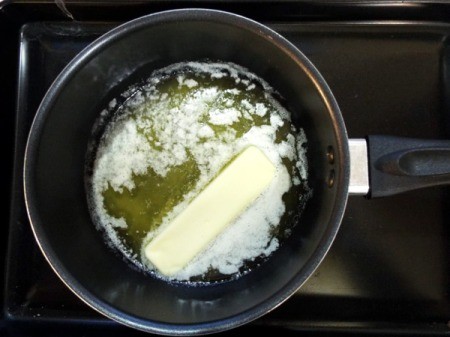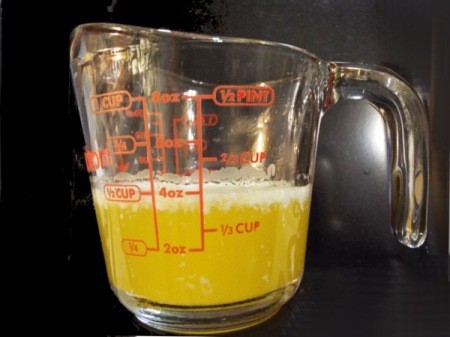 There is clarified butter, and then there is ghe or ghee. They are not the same. Clarified butter, or 'drawn butter', as it was called in times past, is the simpler to prepare of the two. It can be used many ways, including sauteeing steaks, as a dip or dressing for lobster, and as I have recently learned, as an excellent oil for popping corn. Essentially, it is regular butter with the milk solids and water removed.
There is clarified butter, and then there is ghe or ghee. They are not the same. Clarified butter, or 'drawn butter', as it was called in times past, is the simpler to prepare of the two. It can be used many ways, including sauteeing steaks, as a dip or dressing for lobster, and as I have recently learned, as an excellent oil for popping corn. Essentially, it is regular butter with the milk solids and water removed.
Ghee, from the Sanskrit word 'ghri' (meaning to sprinkle), takes longer to prepare, involves more steps in the making, and the resulting product is far more stable, both on the shelf and refrigerated. Ghee has more concentrated flavors which are often described as 'nutty'. These nutty flavors are brought about by the browning of the milk solids before they are removed from the butter fat. Ghee is most often used in the preparation of Indian and Southern Asian cuisine.
Since I discovered how much better popcorn tastes when popped in clarified butter, I have done some experimenting to find the easiest way to prepare the butter. Some people who fry with butter, add an amount of Crisco or other fat to increase the butter's smoking point. When they see how easy it is to clarify butter, I think they will use that and not adulterate their butter's taste with other fats.
Clarified butter can be made in any amount. For the purpose of popping enough corn for one or two servings, I use one stick. This yields enough butter for popping the corn, drizzling a good amount over the popped corn, and unless you like your corn heavy with butter, there will be a tablespoon or two left for some other purpose.
When butter is melted, it separates into three layers. The top layer is milk solids. It is these solids that burn when heated to over 350 degrees. The bottom layer is water, whitish in color. This water must be removed also before using the butter for high temperature sauteeing or popping corn.
I think a lot of people would like to try clarified butter but think it too much trouble to make. That is why I experimented to find the easiest way for me, and I hope for you.
Steps:





I do hope these little tips will encourage someone who thought clarifying butter too time consuming, to give it a try. Your popcorn will thank you. And your omelette. And your pan fried steak. And so on.
Share on ThriftyFunThis page contains the following solutions. Have something to add? Please share your solution!
I don't cook a lot of fried foods but awhile back, I asked for suggestions for a cooking fat that had little or no scent while cooking. I got some responses, and I went with the suggestion that I try ghee or 'clarified butter'.
Ask a QuestionHere are the questions asked by community members. Read on to see the answers provided by the ThriftyFun community or ask a new question.
Does anyone have a recipe on how to make clarified butter using a microwave? No matter how I try, I can't make it on the stove. But I am certainly open to anyone who can give me a simple, fool proof way to do it! Thank you!
Clarified Butter does not need to be refrigerated. Store it in an airtight container in a cupboard or on your kitchen counter. It may be used in place of regular butter in any recipe in this book. One advantage to using Clarified Butter rather than plain salted or unsalted butter is that it doesn't burn when sauteing nuts and other ingredients. It should always be used in filo recipes because the water in salted or unsalted butter will cause the filo to become soggy. Pastries that specify Clarified Butter will not bake as well with plain butter.
To make 3 to 3 1/2 cups of Clarified Butter: Place 2 lb butter (or margarine if you prefer) in a large, deep microwave-safe bowl. The bowl should be large enough to allow the butter to foam up without overflowing. Microwave on medium power for 6 to 8 minutes until completely melted and hot. Remove from microwave and allow to sit for 10 minutes while the milk solids and liquids settle to the bottom. Skim off any foam that has formed on top, and discard. Carefully pour off or ladle out the clear butter. Discard the milk solids and liquids left at the bottom of the bowl.